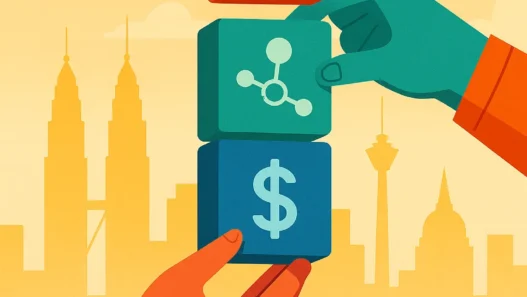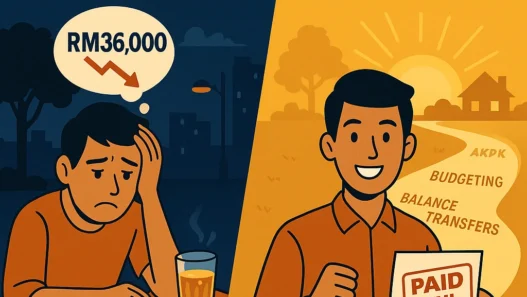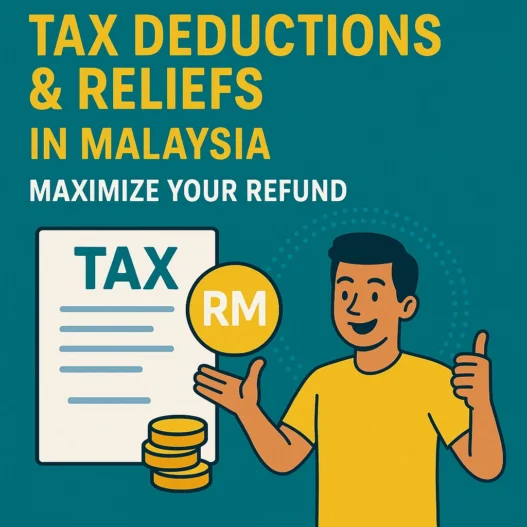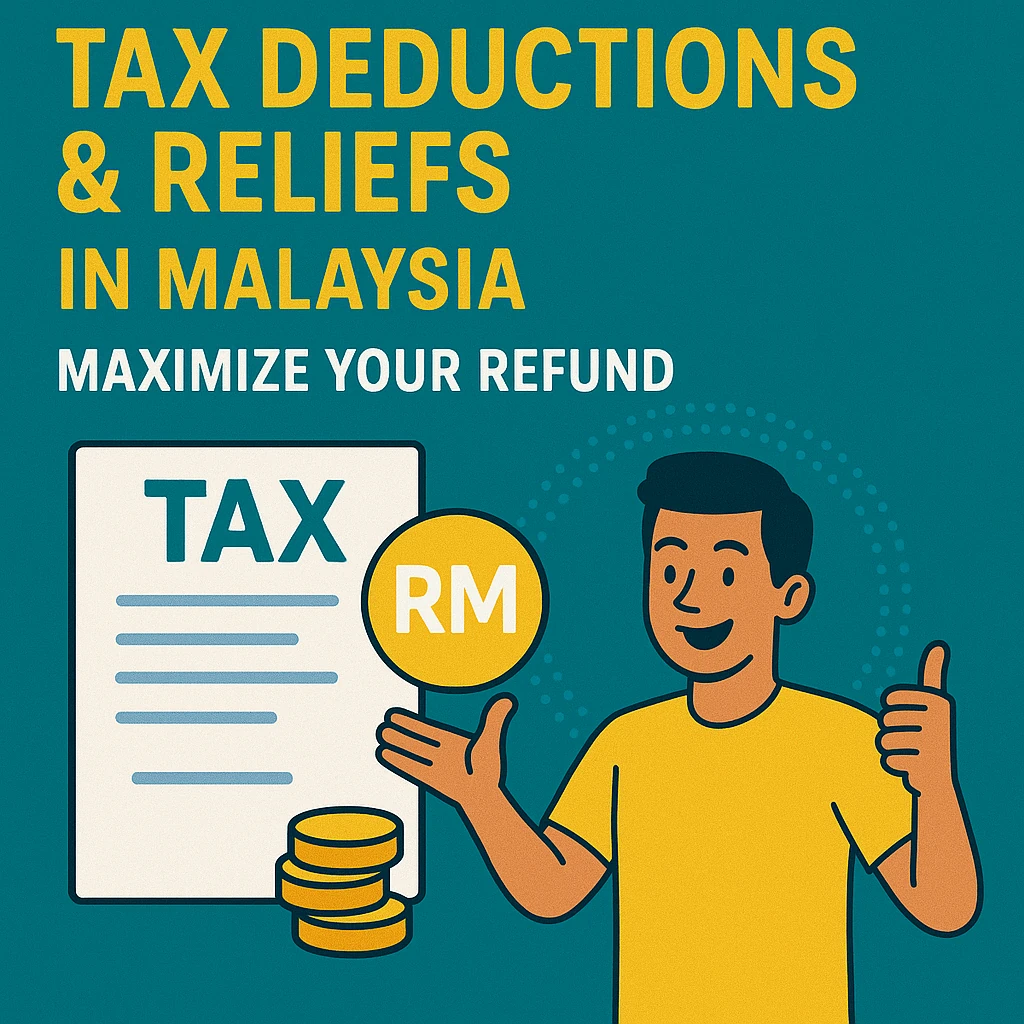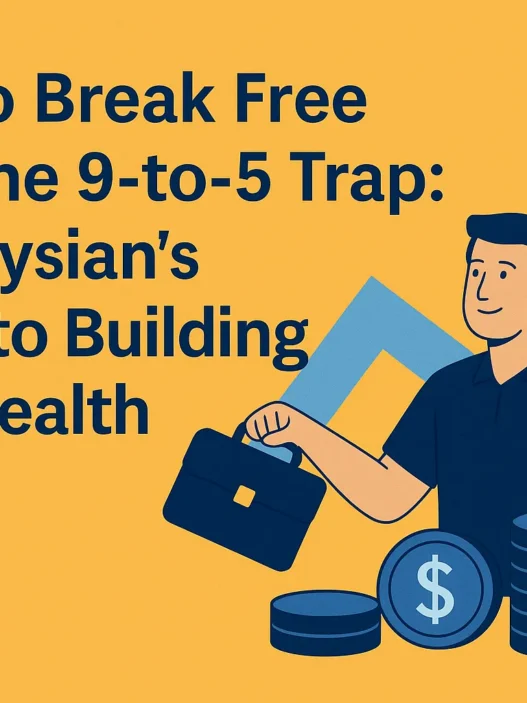Okay, kawan-kawan! Tax season. Just hearing the words can make some of us want to order a large teh tarik and procrastinate, right? But what if I told you that understanding your taxes, especially tax deductions and reliefs, could actually put more money back into your pocket? Yes, you heard that right – more Ringgit for your savings, your family, or even that fine dining craving you’ve been having!
Many of us sail through our formal education learning algebra and history, but when it comes to practical money skills like navigating the Malaysian tax system, we’re often left figuring things out on our own. That’s where this guide comes in. We’re going to break down Tax Deductions & Reliefs in Malaysia for the Year of Assessment 2025 (that’s for e-Filing in 2026!) so you can confidently maximize your refund. This isn’t just about paying less tax; it’s about being smart with your hard-earned money.
This information is especially crucial for us Malaysians. With the rising cost of living, every extra Ringgit counts. Think of tax reliefs not as loopholes, but as government incentives rewarding you for responsible financial behaviour – like saving for retirement, investing in your education, or taking care of your loved ones. So, grab that teh tarik (or kopi O, we don’t judge!), and let’s dive into how you can make the tax system work for you.
Wait, What’s the Difference? Tax Reliefs vs. Tax Deductions
Before we jump into the juicy details, let’s quickly clear up some common terms you’ll see. You might hear “tax relief” and “tax deduction” used a lot. While both help reduce your taxable income, they apply slightly differently:
- Tax Reliefs: These are specific amounts you can subtract from your total annual income for various personal expenditures. Think of things like medical expenses, education fees, or contributions to your EPF and SOCSO. They are generally available to all individual taxpayers who meet the criteria.
- Tax Deductions: These are expenses you can subtract from your gross business income if you’re self-employed or have rental income. These are costs directly incurred in generating that income, like office rent or business travel.
Essentially, both reliefs and deductions lower your chargeable income, which is the amount your tax is actually calculated on. The lower your chargeable income, the less tax you pay – or the bigger your refund! Simple, right?
Understanding Malaysian Income Tax Basics
Before diving into specific tax reliefs and deductions, it’s important to understand some fundamental concepts of the Malaysian income tax system:
- Tax Residence Status: An individual is considered a tax resident in Malaysia if they are physically present in the country for at least 182 days in a calendar year. Good news! Tax residents enjoy more tax reliefs and generally lower tax rates compared to non-residents.
- Assessment Year (YA) vs. Year of Income: The assessment year (YA) refers to the year in which income is assessed for tax purposes, while the year of income is when the income is actually earned. For example, income earned in 2025 will be assessed in the Year of Assessment (YA) 2025, with tax filing typically occurring in early 2026.
- Chargeable Income: This is the magic number! It’s your total income after you’ve subtracted all eligible reliefs and deductions. This is the amount that will be subject to tax.
- Progressive Tax Rates: Malaysia uses a progressive tax rate system for residents. This means the more you earn, the higher the percentage of tax you pay on subsequent portions of your income. Rates for residents range from 0% to 30%. Non-residents, on the other hand, are typically taxed at a flat rate of 30%.
- E-Filing Deadline: Mark your calendars! For individuals without business income, the e-Filing deadline via LHDN’s MyTax portal is usually April 30th following the assessment year. For those with business income, you get a bit more time, typically until June 30th. In 2023, LHDN reported that a significant number of taxpayers utilized e-Filing, highlighting the shift towards digital tax submissions. So, get comfortable with the online system!
Understanding these basics will help you better navigate the tax reliefs and deductions we’re about to discuss and apply them effectively to your unique situation.
How Tax Reliefs and Deductions Actually Work to Save You Money
Okay, let’s imagine your income is like a big delicious cake. The government, through LHDN (Lembaga Hasil Dalam Negeri Malaysia, our Inland Revenue Board), needs a slice. But, before they take their slice, tax reliefs and deductions allow you to make your cake smaller (in a good way!).
Here’s the simple formula:
Total Annual Income
MINUS Tax Reliefs (for personal expenses)
MINUS Tax Deductions (for business expenses, if applicable)
EQUALS Chargeable Income
Then, your Chargeable Income × Tax Rate = Tax Payable.
So, the more reliefs and deductions you legitimately claim, the smaller your chargeable income becomes. This can do two fantastic things:
- Lower the total amount of tax you have to pay.
- Potentially drop you into a lower tax bracket, meaning a lower tax rate applies to a portion of your income!
For example, if your total income is RM80,000 and you claim RM20,000 in reliefs, your chargeable income becomes RM60,000. The tax is then calculated on RM60,000, not RM80,000. That’s a significant difference! Setiap Ringgit dikira, tau! (Every Ringgit counts, you know!)
Now, let’s explore the treasure chest of personal tax reliefs available for YA 2025.
Personal Tax Reliefs for Individuals in Malaysia (YA 2025): Your Key to Savings!
Alright, this is where it gets really interesting! For the Year of Assessment 2025, the Malaysian government has provided a host of personal tax reliefs. Think of these as rewards for spending on essential things or planning for your future. Keep your receipts and records handy!
“Every Ringgit saved through legitimate tax reliefs is a Ringgit earned for your future, your family, or even that extra durian treat you’ve been eyeing!”
Here’s a comprehensive breakdown:
1. Self and Dependent Relatives Relief
- Relief Amount: RM9,000
- Eligibility: This is a fantastic automatic relief given to every individual taxpayer for themselves and their dependent relatives (like parents, if they don’t have their own significant income and you’re supporting them). No complicated forms for this basic one!
- Example: Whether you’re Ali, Ah Meng, or Anusha, if you’re a taxpayer, you get this RM9,000 relief straight off the bat.
2. Disabled Individual Relief
- Relief Amount: RM7,000
- Eligibility:
- Certified Disabled: You must be certified as a disabled person by the Department of Social Welfare (Jabatan Kebajikan Masyarakat or JKM).
- In Addition: This is an additional relief on top of the RM9,000 for self and dependents.
- Example: If Sarah is a registered disabled individual, she can claim RM9,000 (self) + RM7,000 (disabled individual) = RM16,000 in personal reliefs.
3. Disabled Spouse Relief
- Relief Amount: RM6,000
- Eligibility:
- Your Spouse is Disabled: Your husband or wife must be certified as disabled by JKM.
- Lives with You: The disabled spouse must reside with you.
- Income Status: The disabled spouse has no income, OR elects for joint assessment with you.
- Example: Raju’s wife is certified as disabled by JKM. Raju can claim this RM6,000 relief for her, in addition to other applicable reliefs like the standard spouse relief if her income conditions are met.
4. Spouse/Alimony Relief
- Relief Amount: Up to RM4,000
- Eligibility for Spouse Relief:
- Supporting a Spouse: If your spouse has no income or chooses joint assessment in your name, you can claim this.
- No Foreign Income (for spouse): Not eligible if your spouse has gross income exceeding RM4,000 from sources outside Malaysia.
- Eligibility for Alimony Payments:
- To Former Spouse: You can claim for alimony paid to a former spouse under a formal agreement.
- Limit: The deduction is up to RM4,000 or the actual amount paid, whichever is lower.
- Total Cap: The total deduction for both current spouse relief and alimony payments is capped at RM4,000.
- Example: Mei Ling supports her husband who has no income. She can claim RM4,000. If David pays RM3,000 in court-ordered alimony to his ex-wife, he can claim RM3,000.
5. Child Relief – Our Future Generation!
This one has a few categories:
5.1 Basic Child Relief
- Relief Amount: RM2,000 per child
- Eligibility: For each unmarried child under the age of 18.
- Example: Ali and Aisyah have two children aged 10 and 15. They can claim RM2,000 x 2 = RM4,000.
5.2 Child Pursuing Education Relief (Pre-University)
- Relief Amount: RM2,000 per child
- Eligibility: For each unmarried child aged 18 and above who is receiving full-time education (e.g., “A-Level”, certificate, matriculation, or preparatory courses).
- Example: Fatimah’s 19-year-old son is pursuing his A-Levels full-time. She can claim RM2,000 for him.
5.3 Higher Education Child Relief (Diploma & Above)
- Relief Amount: RM8,000 per child
- Eligibility: For each unmarried child aged 18 and above who is:
- Studying in Malaysia: Pursuing a diploma or higher qualification (excluding matriculation/preparatory courses) at an approved institution.
- Studying Overseas: Pursuing a degree or equivalent (including Master’s or Doctorate) at an approved institution.
- Example: Mr. Tan’s daughter is studying for her Bachelor’s Degree at Universiti Malaya. He can claim RM8,000 for her. If his son is doing a degree in Australia, he can also claim RM8,000.
5.4 Disabled Child Relief
- Relief Amount: RM6,000 per disabled child
- Eligibility: For each disabled child (certified by JKM), regardless of their age, as long as they are unmarried. This is in addition to other child reliefs they might qualify for.
- Example: Siti has a 12-year-old child with disabilities. She can claim RM2,000 (basic child relief) + RM6,000 (disabled child relief) = RM8,000 for this child.
5.5 Disabled Child Pursuing Higher Education Relief
- Relief Amount: Additional RM8,000 (making it potentially RM6,000 + RM8,000 = RM14,000 per child)
- Eligibility:
- Disabled Child: Certified by JKM.
- Age 18+ and Unmarried.
- Higher Education: Pursuing diplomas or higher in Malaysia, or Bachelor’s degree or above outside Malaysia, at accredited institutions.
- Example: Encik Lee’s 20-year-old son is disabled and studying for a diploma at a local polytechnic. Lee can claim RM6,000 (disabled child) + RM8,000 (higher education for disabled child) = RM14,000.
6. Parental Care Relief – Giving Back to Our Elders
- Relief Amount: Up to RM8,000 (Restricted)
- Eligibility: For medical treatment, dental treatment (new!), special needs, and carer expenses for your parents.
- Medical Condition: Must be certified by a medical practitioner.
- Parents: Your legitimate parents or foster parents (if you were an adopted child).
- Complete Medical Examination for Parents: This sub-category is restricted to RM1,000 within the RM8,000 limit.
- Example: If Lim spent RM5,000 on his father’s certified medical treatment and RM1,200 on his mother’s approved full medical check-up, he can claim RM5,000 + RM1,000 (capped for check-up) = RM6,000. If he also paid RM3,000 for a carer for his parents, he can claim up to the RM8,000 total limit.
7. Medical Expenses Relief (Self, Spouse, or Child)
- Relief Amount: Up to RM10,000 (Restricted for certain categories)
- Eligibility: Covers a range of medical expenses:
- Serious Diseases: For yourself, spouse, or child (e.g., cancer, heart attack, kidney failure). No sub-limit within the RM10,000.
- Fertility Treatment: For yourself or your spouse. No sub-limit within the RM10,000.
- Vaccination: For self, spouse, or child (restricted to RM1,000 within the RM10,000).
- Diagnostic & Consultation (Combined RM1,000 cap):
- Full Medical Check-up: For self, spouse, or child.
- COVID-19 Tests: Including self-test kits, for self, spouse, or child.
- Mental Health Check-up/Consultation: For self, spouse, or child.
- Dental Examination and Treatment: For self, spouse, or child, for basic dental work (e.g. fillings, scaling, extractions, not cosmetic). Restricted to RM1,000. (New for YA2024 and continued for YA2025).
- Example: Puan Wong spent RM6,000 on her husband’s treatment for a serious illness, RM500 on a full medical check-up for herself, RM300 on COVID-19 test kits for the family, RM800 on her child’s vaccinations, and RM1,200 on dental fillings.
- Serious illness: RM6,000
- Check-up + COVID tests: RM500 + RM300 = RM800 (within RM1k cap for this category)
- Vaccinations: RM800 (within RM1k cap for this category)
- Dental: RM1,000 (capped)
- Total claimable: RM6,000 + RM800 + RM800 + RM1,000 = RM8,600 (within the RM10,000 overall limit).
8. Education Fees Relief (Self-Improvement)
- Relief Amount: Up to RM7,000 (Restricted)
- Eligibility: For your own education fees:
- Sub-Limit for Upskilling/Self-Enhancement: Up to RM2,000 for courses for skill acquisition or self-enhancement recognised under the National Skills Development Act 2006. This RM2,000 is part of the total RM7,000.
- Other Courses (Masters/Doctorate): Any course of study at Masters or Doctorate level in a recognized institution.
- Other Courses (Non-Masters/Doctorate): Courses in fields like law, accounting, Islamic finance, technical, vocational, industrial, scientific, or technology at recognized Malaysian institutions or approved professional bodies.
- Example: Amir is pursuing an MBA locally and paid RM12,000 in fees. He can claim RM7,000. If Devi took a recognized digital marketing course for RM1,500 (upskilling) and a part-time accounting diploma for RM4,000, she can claim RM1,500 + RM4,000 = RM5,500.
9. Lifestyle Relief – Books, Gadgets, Internet & More!
- Relief Amount: Up to RM2,500 (Restricted)
- Eligibility: For yourself, spouse, or child:
- Reading Materials: Purchase of books, journals, magazines, newspapers (printed or electronic, not banned!).
- Personal Tech: Purchase of a personal computer, smartphone, or tablet (not for business use).
- Internet Subscription: Monthly bill under your own name.
- Example: In 2025, Nurul bought a new smartphone for RM1,800, spent RM300 on e-books, and her monthly internet bill (under her name) was RM100 x 12 = RM1,200. Total spent: RM1,800 + RM300 + RM1,200 = RM3,300. She can claim the maximum of RM2,500.
10. Additional Lifestyle Relief – For the Sporty You!
- Relief Amount: Up to RM1,000 (Restricted) – This is an additional relief specifically for sports-related expenses, separate from the RM2,500 lifestyle relief.
- Eligibility: For yourself, spouse, or child:
- Sports Equipment: For activities defined under the Sports Development Act 1997 (e.g., badminton rackets, football boots, bicycle but NOT motorized ones).
- Facility Fees: Rental or entrance fees for sports facilities (e.g., badminton court rental, swimming pool entry).
- Competition Fees: Registration for sports competitions by approved organizers.
- Gym Membership & Sports Training: Fees for gym or sports training/coaching.
- Example: Kumar bought a new pair of running shoes for RM400, paid RM900 for his annual gym membership, and RM100 for a 5km fun run registration. Total: RM1,400. He can claim the maximum of RM1,000.
11. Breastfeeding Equipment Relief
- Relief Amount: Up to RM1,000 (Restricted)
- Eligibility: For working mothers, for the purchase of breastfeeding equipment for their child aged 2 years and below.
- Frequency: Claimable once every TWO years of assessment.
- Example: Aishah, a working mother, purchased a breast pump and accessories for RM800 for her 1-year-old baby in YA 2025. She can claim RM800. She won’t be able to claim this again in YA 2026 if she claimed in YA 2025.
12. Childcare Fees Relief
- Relief Amount: Up to RM3,000 (Restricted)
- Eligibility: Fees paid to a registered childcare center (taska) or kindergarten (tadika) for your child aged 6 years and below.
- Example: The Tans pay RM300 per month (RM3,600 per year) for their 4-year-old daughter’s registered kindergarten. They can claim RM3,000.
13. SSPN (Skim Simpanan Pendidikan Nasional) Relief
- Relief Amount: Up to RM8,000 (Restricted)
- Eligibility: For net deposit in SSPN accounts. Net deposit means total deposits in YA 2025 minus total withdrawals in YA 2025.
- Benefit: SSPN is a popular education savings scheme by PTPTN.
- Example: In 2025, Encik Kamal deposited RM10,000 into his child’s SSPN Prime account and made no withdrawals. He can claim the maximum relief of RM8,000. This is a great way to save for your child’s future education and get tax benefits!
14. Life Insurance and EPF (KWSP) Relief
- Relief Amount: Up to RM7,000 (Combined and restricted)
- Eligibility: This is a combined relief with specific caps:
- Category 1 (Pensionable Public Servants): Life insurance premiums or Takaful contributions – up to RM7,000.
- Category 2 (Non-Public Servants/Private Sector):
- Mandatory EPF/Approved Scheme Contributions: Up to RM4,000.
- Life Insurance Premiums/Takaful Contributions OR Additional Voluntary EPF Contributions: Up to RM3,000.
- The total for Category 2 is RM4,000 + RM3,000 = RM7,000.
- Example (Private Sector): Bala contributes RM5,000 annually to EPF (mandatory). He also pays RM2,500 for his life insurance policy. He can claim RM4,000 for EPF and RM2,500 for life insurance, totaling RM6,500. If he wanted to maximize this, he could increase his life insurance premium by RM500 or make a voluntary EPF contribution of RM500 to hit the RM3,000 cap for that portion.
15. Deferred Annuity and Private Retirement Scheme (PRS) Relief
- Relief Amount: Up to RM3,000 (Restricted)
- Eligibility: Contributions to:
- Deferred Annuity Schemes.
- Private Retirement Schemes (PRS): Approved by the Securities Commission Malaysia. This is on top of your EPF!
- PRS Growth: PRS assets under management in Malaysia have seen steady growth, indicating more Malaysians are taking up this option for supplementary retirement savings.
- Example: Leong contributed RM200 per month (RM2,400 per year) to his PRS account. He can claim RM2,400. If he tops up another RM600 before year-end, he can claim the full RM3,000.
16. Education and Medical Insurance Relief
- Relief Amount: Up to RM3,000 (Restricted)
- Eligibility: Premiums paid for education insurance or medical insurance (medical card) for yourself, spouse, or child.
- Example: Puan Zainab pays RM1,800 for her family’s medical card and RM1,500 for her child’s education policy. Total paid: RM3,300. She can claim the maximum RM3,000.
17. SOCSO (PERKESO) Contribution Relief
- Relief Amount: Up to RM350 (Restricted)
- Eligibility: For your contributions to the Social Security Organisation (SOCSO/PERKESO) under the Employees’ Social Security Act 1969 or the Self-Employment Social Security Act 2017.
- Check Your Payslip: Your monthly SOCSO contributions are usually itemized on your payslip if you’re an employee.
- Example: David’s total SOCSO contributions for the year amount to RM300. He can claim the full RM300. If he contributed RM400, he could claim up to RM350.
18. Electric Vehicle (EV) Charging Facilities Relief
- Relief Amount: Up to RM2,500 (Restricted)
- Eligibility: For expenses related to the installation, rental, purchase (including hire-purchase) of EV charging facilities for your own use (not for business). This is part of Malaysia’s push for green technology!
- Example: Mei decided to go green and bought an EV. She spent RM3,000 installing an EV charger at her home. She can claim RM2,500 for YA 2025.
19. Supporting Equipment for Disabled Self, Spouse, Child, or Parent
- Relief Amount: Up to RM6,000 (Restricted)
- Eligibility: Purchase of basic supporting equipment for yourself, spouse, child, or parent if they are disabled (and certified by JKM). Equipment includes items like wheelchairs, hearing aids, artificial limbs, etc.
- Example: Ramesh’s father is a registered disabled person. Ramesh purchased a new, medically required wheelchair for his father for RM4,500. He can claim RM4,500.
20. Expenses for Child with Disabilities (Learning/Intervention)
- Relief Amount: Up to RM4,000 (Restricted)
- Eligibility: For a child aged 18 and below, certified with a learning disability. Expenses include:
- Assessment of intellectual disability diagnosis.
- Early intervention programmes / intellectual disability rehabilitation treatment.
- Example: Anita’s 6-year-old son was diagnosed with a learning disability. She spent RM5,000 on a registered early intervention program for him. She can claim the maximum relief of RM4,000.
Phew! That’s a lot of reliefs, right? Remember to keep all your receipts and relevant documents meticulously. Simpan baik-baik, ya!
Tax Deductions for Self-Employed Individuals in Malaysia (YA 2025): Running Your Business Smartly!
If you’re a freelancer, consultant, run your own online store, or any other business as a sole proprietor or partner, this section is for you! Unlike salaried employees, self-employed individuals can deduct business expenses incurred “wholly and exclusively” in the production of their business income.
“For the Malaysian entrepreneur, understanding tax deductions isn’t just about compliance; it’s about smart business management that fuels growth.”
Here are common categories of allowable business expenses:
1. Staff Costs (If You Have Employees)
- Salaries, Wages, Bonuses, Allowances: Payments made to your employees. Must be reasonable.
- EPF & SOCSO Contributions (Employer’s Share): Your portion of statutory contributions for your staff.
- Staff Training: Costs to upskill your team, sometimes even eligible for double deduction if approved under specific schemes (e.g., HRD Corp levy payers).
- Example: If “Syarikat Ali Baba Bujang Lapok Services” pays RM5,000 monthly salary to an admin assistant and contributes the employer’s share of EPF and SOCSO, these are deductible.
2. Rent & Utilities for Business Premises
- Office/Shop Rental: Monthly rent paid for your business space.
- Utilities: Electricity, water, internet, and phone bills for your business.
- Home Office Expenses (Partial): If you use a dedicated part of your home exclusively for business, you can deduct a portion of your home expenses (rent/mortgage interest, utilities). Calculation must be reasonable (e.g., based on square footage).
- Example: If Kak Ros uses one room in her house (20% of total area) solely for her online baking business, she can deduct 20% of relevant household bills like electricity and internet.
3. Repairs & Maintenance
- Business Premises: Minor repairs to keep your office/shop in good condition (e.g., fixing a leaky tap, repainting a wall).
- Equipment: Servicing your business computers, machinery, or vehicles.
- Important: These are for repairs, not improvements or capital additions that extend the asset’s life or capability – those fall under capital allowances.
- Example: The cost of repairing the air-conditioner in your consulting office is deductible.
4. Travel & Transportation for Business
- Fuel & Vehicle Maintenance: For business-related travel. If you use your personal car for business, you need to apportion the expenses (e.g., keep a logbook).
- Public Transport, Flights, Accommodation: For outstation or overseas business trips to meet clients or suppliers.
- Example: David, a freelance photographer, travels to Penang for a client shoot. His flight, hotel, and local transport costs for the trip are deductible.
5. Marketing & Advertising
- Online Ads: Facebook ads, Google ads, influencer marketing costs.
- Traditional Ads: Newspaper ads, flyers, brochures.
- Website Costs: Hosting, domain renewal, maintenance for your business website.
- Example: If “Kedai Runcit Mak Limah” spends RM500 on flyers for a local promotion, that’s deductible.
6. Professional Fees
- Accounting & Tax Fees: Fees paid to your accountant or tax agent.
- Legal Fees: For business-related matters (e.g., drafting contracts), but not for capital transactions.
- Consultancy Fees: If you hire a consultant for your business.
- Example: Paying an accountant RM1,000 to prepare your business accounts and tax submission is deductible.
7. Interest on Business Loans
- Loan Interest: Interest paid on bank loans or financing taken specifically for your business operations or to purchase business assets.
- Example: If you took a business loan to buy new equipment, the interest portion of your monthly repayments is deductible.
8. Capital Allowances (Instead of Depreciation)
Businesses can’t deduct accounting depreciation. Instead, LHDN allows for “Capital Allowances” (CA) on qualifying capital expenditure for business assets like machinery, office equipment, computers, and vehicles.
- Initial Allowance (IA): A one-off claim in the first year the asset is used (typically 20%).
- Annual Allowance (AA): Claimed yearly at a prescribed rate (e.g., computers 20%, general plant & machinery 14%, motor vehicles 20%) until the asset is fully written off.
- Accelerated Capital Allowance (ACA): For certain assets like ICT equipment and software, or small value assets (each below RM2,000, total claim capped at RM20,000 per year), you might be able to claim 100% allowance in one year!
- Example: If you buy a new laptop for your business for RM4,000:
- IA: 20% of RM4,000 = RM800 (Year 1)
- AA: 20% of RM4,000 = RM800 (Year 1, and subsequent years until fully claimed)
- If it was a small value asset under RM2,000, you could potentially claim 100% in Year 1.
9. Bad Debts
- Specific Bad Debts Written Off: If a customer owes you money for goods/services already delivered (and you’ve already recognized this as income), and you’ve taken reasonable steps to recover it but failed, you can deduct this amount when you write it off.
- General Provisions for Bad Debts: Not deductible. It must be a specific debt proven to be bad.
- Example: If “Ah Tan Electrical Services” did a job worth RM500, invoiced the client, but the client disappeared and is uncontactable after many attempts, Ah Tan can write off this RM500 as a bad debt.
10. Zakat for Business
- Muslim business owners can claim a deduction for business Zakat paid to the relevant religious authorities. This is a direct deduction from aggregate income.
- Example: If Puan Aminah’s online hijab business pays RM2,000 in business Zakat, this amount is deductible.
Key for Self-Employed: Record Keeping is King (and Queen)! Meticulous record-keeping is non-negotiable. Keep all invoices, receipts, bank statements, and payment vouchers organized. LHDN can request these for audit for up to 7 years. Digital tools and accounting software can be a lifesaver here!
Tax Strategies and Tips: Making Your Money Work Harder!
Knowing the reliefs and deductions is one thing; strategically using them is another. Here are some tips for both salaried employees and self-employed individuals in Malaysia:
“Maximizing your tax refund isn’t a once-a-year affair; it’s a result of mindful financial habits cultivated throughout the year.”
For Everyone:
- Plan Your Purchases & Payments:
- Lifestyle & Sports Reliefs: Need a new laptop or sports gear? If you haven’t maxed out these reliefs (RM2,500 and RM1,000 respectively), consider buying them before year-end.
- Medical Expenses: If you have non-urgent medical check-ups or dental work planned, and haven’t hit the relief limits, scheduling them before December 31st can help for the current YA.
- SSPN & PRS: Top up these accounts before year-end to maximize the RM8,000 (SSPN) and RM3,000 (PRS) reliefs. These are fantastic for long-term savings and tax benefits.
- Zakat/Donations: If you plan to pay Zakat or make donations to approved institutions (deductible up to 10% of aggregate income), doing so before year-end ensures they count for the current YA.
- Married? To File Jointly or Separately? Itu Soalan!
- No One-Size-Fits-All: Generally, if one spouse earns significantly more than the other (or one spouse has no income), joint assessment might be beneficial.
- Do the Math: If both spouses have taxable income, calculate your tax liability under both separate and joint assessment (LHDN’s e-Filing system usually allows you to see both scenarios). Choose the one that results in lower total tax.
- Child Reliefs: If filing separately, usually the spouse with the higher income claims the child reliefs to get a bigger tax benefit due to being in a higher tax bracket.
- Keep Flawless Records:
- The Golden Rule: No receipt, no claim! Store all receipts, invoices, statements, and certificates digitally or in a dedicated file for at least 7 years.
- Track Throughout the Year: Don’t wait until March or April to start digging for documents. Use a simple spreadsheet or an app to track eligible expenses as you incur them.
- Understand What’s Claimable:
- Familiarize yourself with the list of reliefs each year, as they can change with new budget announcements. What wasn’t claimable last year might be claimable now (like certain dental expenses recently!).
Specific for Salaried Employees:
- Maximize EPF & Life Insurance:
- Your mandatory EPF contributions are already a good start. Check if your life insurance premiums plus your mandatory EPF (up to RM4,000 cap for EPF portion) help you hit the RM7,000 combined relief. If not, consider increasing your life insurance coverage or making voluntary EPF contributions.
- Invest in Yourself (Education Relief):
- Taking up a Master’s, Doctorate, or even certain professional/upskilling courses? The fees (up to RM7,000) are claimable. It’s a win-win: you gain knowledge, and you save on tax!
Specific for Self-Employed:
- Home Office Deduction:
- If you genuinely use a part of your home exclusively for your business, calculate and claim a portion of household expenses like utilities, internet, and even rent/mortgage interest. Be fair and reasonable in your apportionment.
- Capital Allowances Strategically:
- Time your purchase of business assets. If you need new equipment and your income is high this year, buying it before year-end allows you to claim Initial Allowance (and Annual Allowance) for that YA.
- For assets under RM2,000 each, utilize the Accelerated Capital Allowance (ACA) for 100% write-off in one year (total ACA capped at RM20,000).
- Separate Bank Accounts:
- Always maintain a separate bank account for your business. It makes tracking income and expenses (and proving them to LHDN) much, much easier. Jangan campur aduk! (Don’t mix them up!)
Real-Life Scenario: The Ahmad Family (YA 2025)
Let’s see how this plays out for a hypothetical Malaysian family:
- Ahmad: Salaried, earns RM70,000 annually.
- Siti (Ahmad’s wife): Salaried, earns RM50,000 annually.
- Children: Two kids, one aged 8 (primary school), one aged 5 (registered tadika).
- Parents: Ahmad supports his elderly mother, who has certified medical expenses of RM3,000.
Key Actions & Reliefs for Ahmad (filing separately):
- Self: RM9,000
- EPF (11% of RM70k = RM7,700, claims RM4,000 cap) + Life Insurance (RM2,000): Total RM6,000
- Parental Care (Mother’s medical): RM3,000
- Child 1 (aged 8): RM2,000
- SSPN (net deposit for kids): RM4,000 (they share the RM8k relief with Siti)
- Lifestyle (books, internet): RM1,500
- Medical Insurance for family: RM2,500
- Total Reliefs for Ahmad: RM9,000 + RM6,000 + RM3,000 + RM2,000 + RM4,000 + RM1,500 + RM2,500 = RM28,000
- Ahmad’s Chargeable Income: (RM70,000 – RM7,700 EPF) – RM28,000 = RM62,300 – RM28,000 = RM34,300
Key Actions & Reliefs for Siti (filing separately):
- Self: RM9,000
- EPF (11% of RM50k = RM5,500, claims RM4,000 cap) + Life Insurance (RM1,000): Total RM5,000
- Child 2 (aged 5, tadika fees RM3,500): Claims RM2,000 (basic child) + RM3,000 (childcare fees) = RM5,000
- SSPN (net deposit for kids): RM4,000
- Lifestyle (new phone): RM2,000
- Total Reliefs for Siti: RM9,000 + RM5,000 + RM5,000 + RM4,000 + RM2,000 = RM25,000
- Siti’s Chargeable Income: (RM50,000 – RM5,500 EPF) – RM25,000 = RM44,500 – RM25,000 = RM19,500
By strategically claiming reliefs and filing separately (which is likely better given their income levels are not vastly different), the Ahmad family significantly reduces their overall tax burden. They could also explore joint assessment to confirm which is best.
Conclusion: Take Charge of Your Taxes!
Navigating Malaysian tax deductions and reliefs might seem daunting at first, but as you can see, it’s all about understanding the system and being proactive. These reliefs and deductions are there for you to use – legally and ethically!
“Don’t leave money on the LHDN table – claim what’s rightfully yours and make your taxes work for you!”
Here are your key takeaways:
- Know Your Reliefs & Deductions: Familiarize yourself with the latest list for YA 2025.
- Keep Meticulous Records: Receipts, invoices, statements – they are your best friends during tax season.
- Plan Ahead: Don’t wait until e-Filing season. Think about tax-efficient spending and saving throughout the year.
- Choose the Right Filing Status: If married, compare joint vs. separate assessment.
- Use LHDN’s Resources: The MyTax portal and LHDN website (hasil.gov.my) are valuable resources.
- When in Doubt, Ask: If your tax situation is complex, consider consulting a certified tax professional. It can be a worthwhile investment.
By applying this knowledge, you’re not just saving money; you’re becoming a smarter, more empowered Malaysian taxpayer. So, go forth and maximize that refund for YA 2025! Your wallet will thank you.
Want to learn more about managing your finances in Malaysia? Explore other articles on our portal for tips on budgeting, investing, and more!



